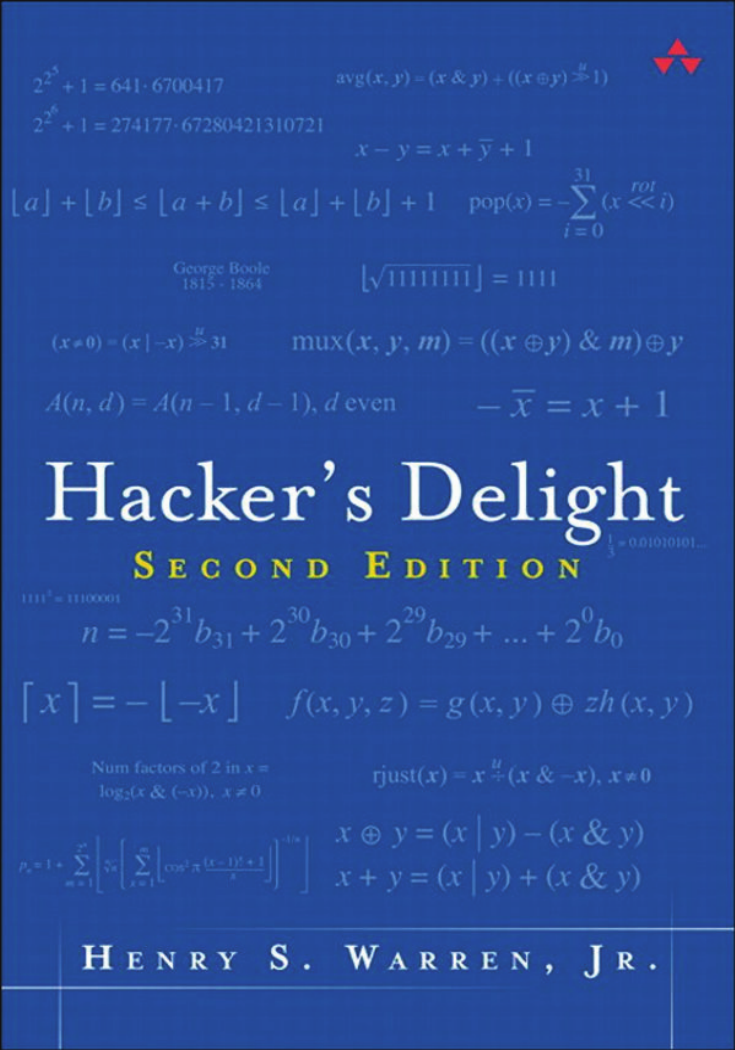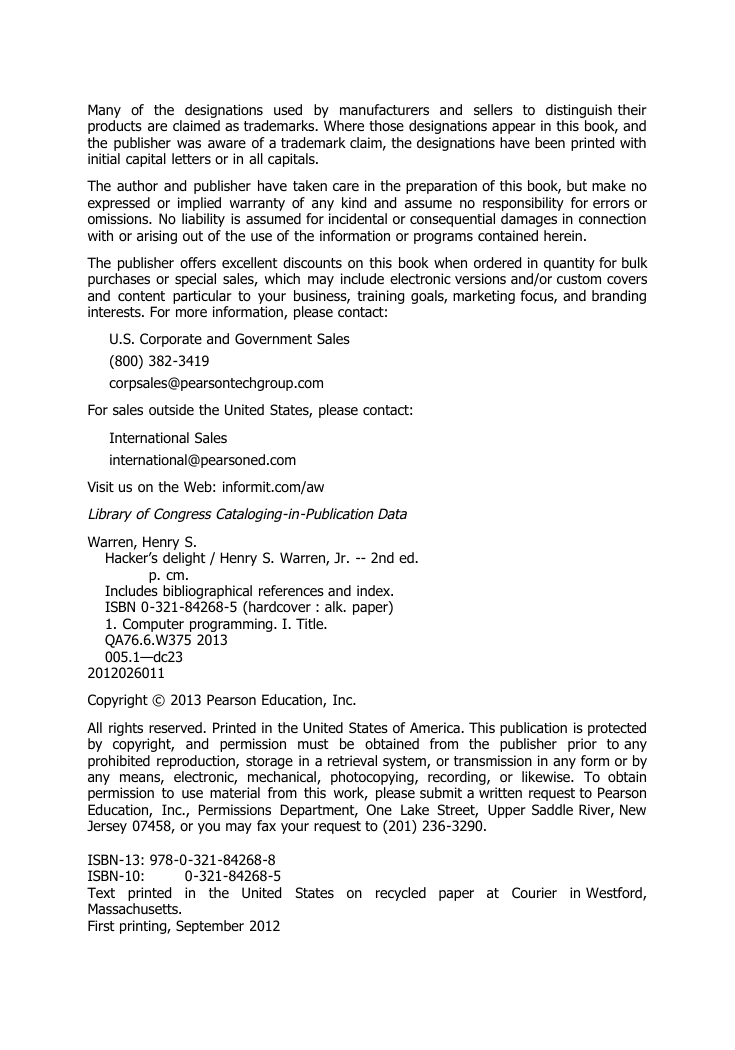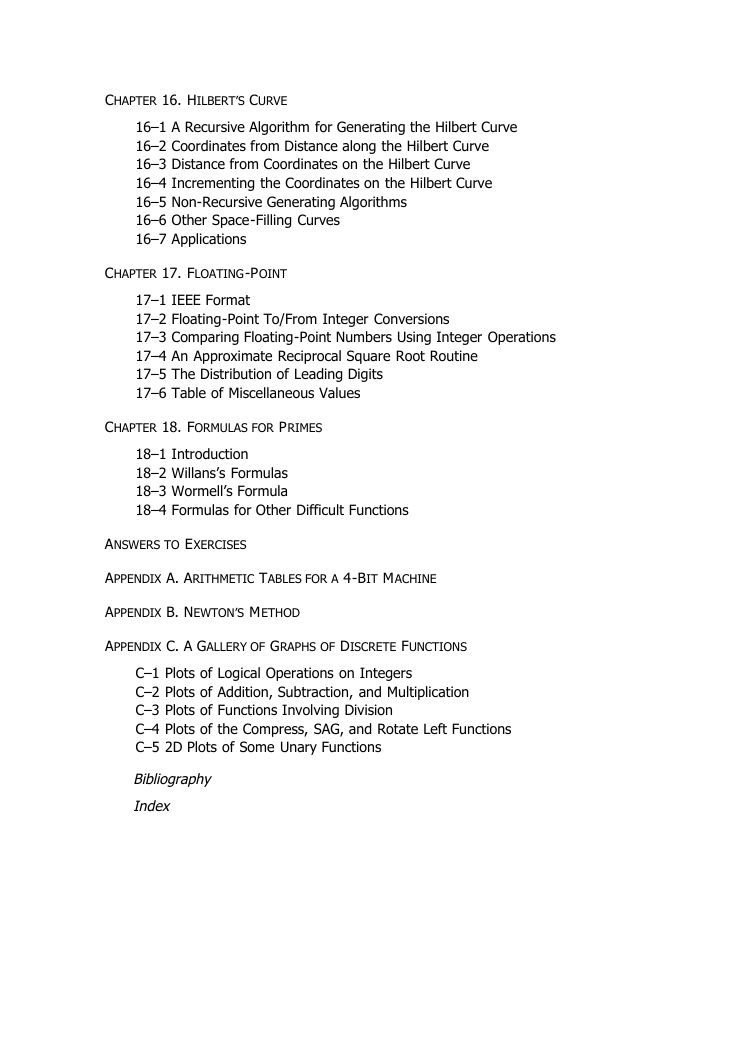�
Hacker’s Delight
Second Edition
Henry S. Warren, Jr.
Upper Saddle River, NJ • Boston • Indianapolis • San Francisco
New York • Toronto • Montreal • London • Munich • Paris • Madrid
CapeTown • Sydney • Tokyo • Singapore • Mexico City
To Joseph W. Gauld, my high school algebra teacher, for sparking in me a delight in the
simple things in mathematics
�
Many of the designations used by manufacturers and sellers to distinguish their
products are claimed as trademarks. Where those designations appear in this book, and
the publisher was aware of a trademark claim, the designations have been printed with
initial capital letters or in all capitals.
The author and publisher have taken care in the preparation of this book, but make no
expressed or implied warranty of any kind and assume no responsibility for errors or
omissions. No liability is assumed for incidental or consequential damages in connection
with or arising out of the use of the information or programs contained herein.
The publisher offers excellent discounts on this book when ordered in quantity for bulk
purchases or special sales, which may include electronic versions and/or custom covers
and content particular to your business, training goals, marketing focus, and branding
interests. For more information, please contact:
U.S. Corporate and Government Sales
(800) 382-3419
corpsales@pearsontechgroup.com
For sales outside the United States, please contact:
International Sales
international@pearsoned.com
Visit us on the Web: informit.com/aw
Library of Congress Cataloging-in-Publication Data
Warren, Henry S.
Hacker’s delight / Henry S. Warren, Jr. -- 2nd ed.
p. cm.
Includes bibliographical references and index.
ISBN 0-321-84268-5 (hardcover : alk. paper)
1. Computer programming. I. Title.
QA76.6.W375 2013
005.1—dc23
2012026011
Copyright © 2013 Pearson Education, Inc.
All rights reserved. Printed in the United States of America. This publication is protected
by copyright, and permission must be obtained from the publisher prior to any
prohibited reproduction, storage in a retrieval system, or transmission in any form or by
any means, electronic, mechanical, photocopying, recording, or likewise. To obtain
permission to use material from this work, please submit a written request to Pearson
Education, Inc., Permissions Department, One Lake Street, Upper Saddle River, New
Jersey 07458, or you may fax your request to (201) 236-3290.
ISBN-13: 978-0-321-84268-8
ISBN-10: 0-321-84268-5
Text printed in the United States on recycled paper at Courier in Westford,
Massachusetts.
First printing, September 2012
�
Contents
Foreword
Preface
CHAPTER 1. INTRODUCTION
1–1 Notation
1–2 Instruction Set and Execution Time Model
CHAPTER 2. BASICS
2–1 Manipulating Rightmost Bits
2–2 Addition Combined with Logical Operations
2–3 Inequalities among Logical and Arithmetic Expressions
2–4 Absolute Value Function
2–5 Average of Two Integers
2–6 Sign Extension
2–7 Shift Right Signed from Unsigned
2–8 Sign Function
2–9 Three-Valued Compare Function
2–10 Transfer of Sign Function
2–11 Decoding a “Zero Means 2**n” Field
2–12 Comparison Predicates
2–13 Overflow Detection
2–14 Condition Code Result of Add, Subtract, and Multiply
2–15 Rotate Shifts
2–16 Double-Length Add/Subtract
2–17 Double-Length Shifts
2–18 Multibyte Add, Subtract, Absolute Value
2–19 Doz, Max, Min
2–20 Exchanging Registers
2–21 Alternating among Two or More Values
2–22 A Boolean Decomposition Formula
2–23 Implementing Instructions for all 16 Binary Boolean Operations
CHAPTER 3. POWER-OF-2 BOUNDARIES
3–1 Rounding Up/Down to a Multiple of a Known Power of 2
3–2 Rounding Up/Down to the Next Power of 2
3–3 Detecting a Power-of-2 Boundary Crossing
CHAPTER 4. ARITHMETIC BOUNDS
4–1 Checking Bounds of Integers
4–2 Propagating Bounds through Add’s and Subtract’s
4–3 Propagating Bounds through Logical Operations
�
CHAPTER 5. COUNTING BITS
5–1 Counting 1-Bits
5–2 Parity
5–3 Counting Leading 0’s
5–4 Counting Trailing 0’s
CHAPTER 6. SEARCHING WORDS
6–1 Find First 0-Byte
6–2 Find First String of 1-Bits of a Given Length
6–3 Find Longest String of 1-Bits
6–4 Find Shortest String of 1-Bits
CHAPTER 7. REARRANGING BITS AND BYTES
7–1 Reversing Bits and Bytes
7–2 Shuffling Bits
7–3 Transposing a Bit Matrix
7–4 Compress, or Generalized Extract
7–5 Expand, or Generalized Insert
7–6 Hardware Algorithms for Compress and Expand
7–7 General Permutations, Sheep and Goats Operation
7–8 Rearrangements and Index Transformations
7–9 An LRU Algorithm
CHAPTER 8. MULTIPLICATION
8–1 Multiword Multiplication
8–2 High-Order Half of 64-Bit Product
8–3 High-Order Product Signed from/to Unsigned
8–4 Multiplication by Constants
CHAPTER 9. INTEGER DIVISION
9–1 Preliminaries
9–2 Multiword Division
9–3 Unsigned Short Division from Signed Division
9–4 Unsigned Long Division
9–5 Doubleword Division from Long Division
CHAPTER 10. INTEGER DIVISION BY CONSTANTS
10–1 Signed Division by a Known Power of 2
10–2 Signed Remainder from Division by a Known Power of 2
10–3 Signed Division and Remainder by Non-Powers of 2
10–4 Signed Division by Divisors ≥ 2
10–5 Signed Division by Divisors ≤ –2
10–6 Incorporation into a Compiler
10–7 Miscellaneous Topics
10–8 Unsigned Division
�
10–9 Unsigned Division by Divisors ≥ 1
10–10 Incorporation into a Compiler (Unsigned)
10–11 Miscellaneous Topics (Unsigned)
10–12 Applicability to Modulus and Floor Division
10–13 Similar Methods
10–14 Sample Magic Numbers
10–15 Simple Code in Python
10–16 Exact Division by Constants
10–17 Test for Zero Remainder after Division by a Constant
10–18 Methods Not Using Multiply High
10–19 Remainder by Summing Digits
10–20 Remainder by Multiplication and Shifting Right
10–21 Converting to Exact Division
10–22 A Timing Test
10–23 A Circuit for Dividing by 3
CHAPTER 11. SOME ELEMENTARY FUNCTIONS
11–1 Integer Square Root
11–2 Integer Cube Root
11–3 Integer Exponentiation
11–4 Integer Logarithm
CHAPTER 12. UNUSUAL BASES FOR NUMBER SYSTEMS
12–1 Base –2
12–2 Base –1 + i
12–3 Other Bases
12–4 What Is the Most Efficient Base?
CHAPTER 13. GRAY CODE
13–1 Gray Code
13–2 Incrementing a Gray-Coded Integer
13–3 Negabinary Gray Code
13–4 Brief History and Applications
CHAPTER 14. CYCLIC REDUNDANCY CHECK
14–1 Introduction
14–2 Theory
14–3 Practice
CHAPTER 15. ERROR-CORRECTING CODES
15–1 Introduction
15–2 The Hamming Code
15–3 Software for SEC-DED on 32 Information Bits
15–4 Error Correction Considered More Generally
�
CHAPTER 16. HILBERT’S CURVE
16–1 A Recursive Algorithm for Generating the Hilbert Curve
16–2 Coordinates from Distance along the Hilbert Curve
16–3 Distance from Coordinates on the Hilbert Curve
16–4 Incrementing the Coordinates on the Hilbert Curve
16–5 Non-Recursive Generating Algorithms
16–6 Other Space-Filling Curves
16–7 Applications
CHAPTER 17. FLOATING-POINT
17–1 IEEE Format
17–2 Floating-Point To/From Integer Conversions
17–3 Comparing Floating-Point Numbers Using Integer Operations
17–4 An Approximate Reciprocal Square Root Routine
17–5 The Distribution of Leading Digits
17–6 Table of Miscellaneous Values
CHAPTER 18. FORMULAS FOR PRIMES
18–1 Introduction
18–2 Willans’s Formulas
18–3 Wormell’s Formula
18–4 Formulas for Other Difficult Functions
ANSWERS TO EXERCISES
APPENDIX A. ARITHMETIC TABLES FOR A 4-BIT MACHINE
APPENDIX B. NEWTON’S METHOD
APPENDIX C. A GALLERY OF GRAPHS OF DISCRETE FUNCTIONS
C–1 Plots of Logical Operations on Integers
C–2 Plots of Addition, Subtraction, and Multiplication
C–3 Plots of Functions Involving Division
C–4 Plots of the Compress, SAG, and Rotate Left Functions
C–5 2D Plots of Some Unary Functions
Bibliography
Index
�
















 2023年江西萍乡中考道德与法治真题及答案.doc
2023年江西萍乡中考道德与法治真题及答案.doc 2012年重庆南川中考生物真题及答案.doc
2012年重庆南川中考生物真题及答案.doc 2013年江西师范大学地理学综合及文艺理论基础考研真题.doc
2013年江西师范大学地理学综合及文艺理论基础考研真题.doc 2020年四川甘孜小升初语文真题及答案I卷.doc
2020年四川甘孜小升初语文真题及答案I卷.doc 2020年注册岩土工程师专业基础考试真题及答案.doc
2020年注册岩土工程师专业基础考试真题及答案.doc 2023-2024学年福建省厦门市九年级上学期数学月考试题及答案.doc
2023-2024学年福建省厦门市九年级上学期数学月考试题及答案.doc 2021-2022学年辽宁省沈阳市大东区九年级上学期语文期末试题及答案.doc
2021-2022学年辽宁省沈阳市大东区九年级上学期语文期末试题及答案.doc 2022-2023学年北京东城区初三第一学期物理期末试卷及答案.doc
2022-2023学年北京东城区初三第一学期物理期末试卷及答案.doc 2018上半年江西教师资格初中地理学科知识与教学能力真题及答案.doc
2018上半年江西教师资格初中地理学科知识与教学能力真题及答案.doc 2012年河北国家公务员申论考试真题及答案-省级.doc
2012年河北国家公务员申论考试真题及答案-省级.doc 2020-2021学年江苏省扬州市江都区邵樊片九年级上学期数学第一次质量检测试题及答案.doc
2020-2021学年江苏省扬州市江都区邵樊片九年级上学期数学第一次质量检测试题及答案.doc 2022下半年黑龙江教师资格证中学综合素质真题及答案.doc
2022下半年黑龙江教师资格证中学综合素质真题及答案.doc